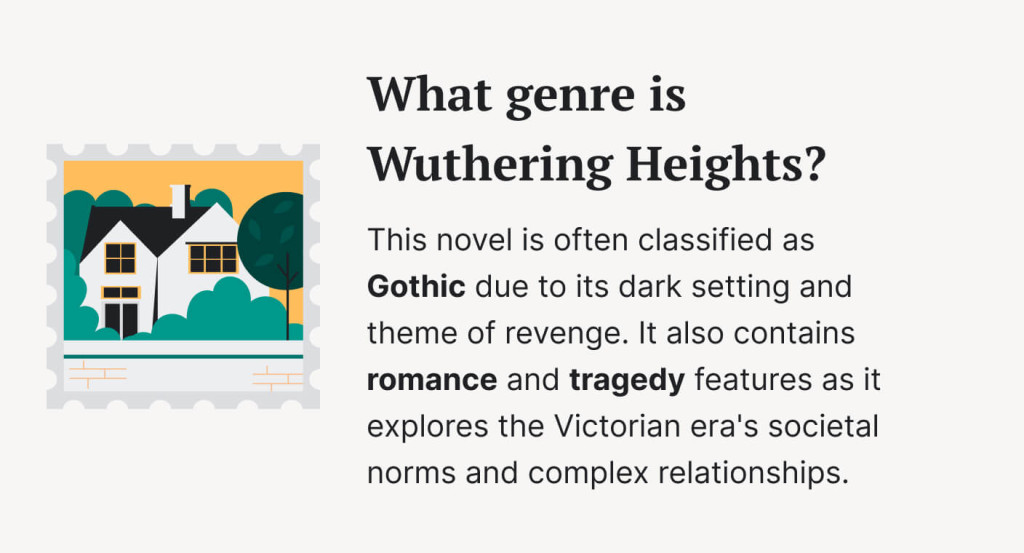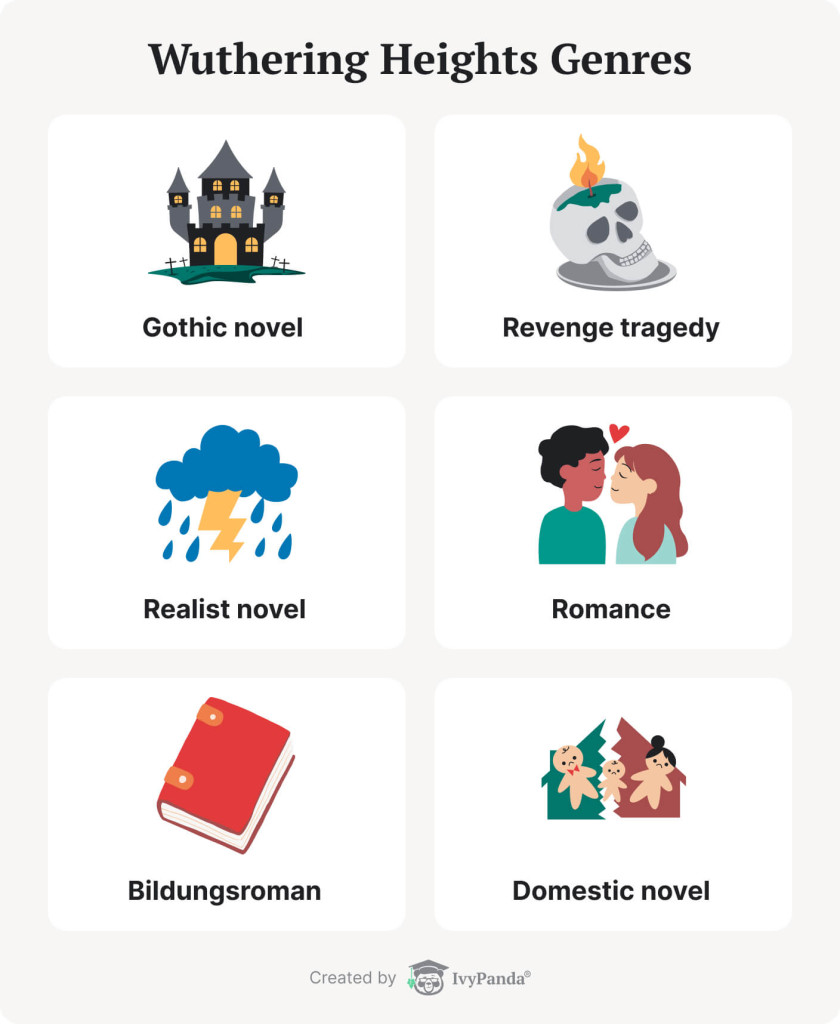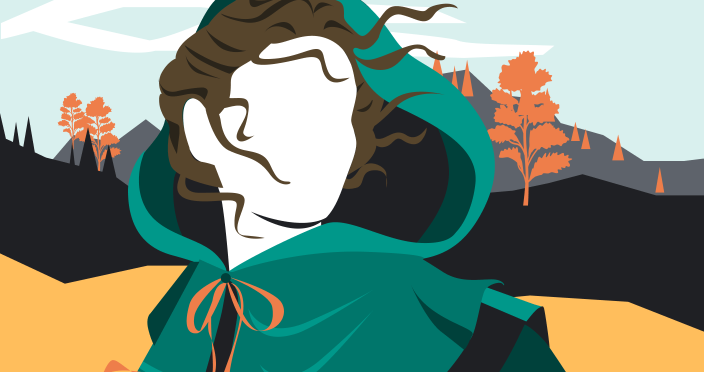Emily Bronte’s only novel, Wuthering Heights, captivates modern readers. It has a rightful place among the masterpieces of English literature. Somerset Maugham, the famous novelist and literary critic, called Wuthering Heights one of the best novels in history. But this wasn’t always the case. Its road to recognition has been long and tedious. In many ways, this happened because the writer’s style didn’t follow the canons of Victorian prose.
19th-century critics had trouble pinpointing the exact literary genre of Emily Bronte’s novel. The work of fiction was also heavily criticized over the years. Despite its clear gothic nature, the book has the traits of other genres. The IvyPanda team has explained why it is also called a tragedy, a romance, and a realist novel.
Check out our article to learn more about the versatility of the Wuthering Heights genre!
💔 What Genre Is Wuthering Heights?
Wuthering Heights by Emily Bronte is mainly considered gothic literature because it heavily uses the special features of this genre. It’s set in a secluded castle, has ghosts appear, and delves into the themes of life and death. Like a true gothic novel, it also has the themes of imprisonment, escape, and persecuted heroes. Heathcliff is a perfect example of a gothic character, with an air of mysteriousness all around him.

In addition to being a gothic tale, Emily Bronte’s book has elements of a revenge tragedy. Heathcliff spends most of the story’s events reveling in the misery the Earnshaws and Lintons families go through for treating him poorly. It also balances the characteristics of romanticism and realism, telling a love story but not shying away from the harsh conditions of life. These components coexist in the text, adding a unique atmosphere to the Wuthering Heights story.
🎭 Wuthering Heights Genre: The Novel’s Versatility
Emily Bronte’s novel shows its enduring relevance in literature for the past couple of centuries. Here, we’ll show how the complex themes and structure of Wuthering Heights challenge traditional genre boundaries. Let’s take a closer look at the intricacies of this novel.

Wuthering Heights as a Gothic Novel
Bronte’s novel is considered a gothic romance because of its setting and plot. The events take place in a secluded English countryside, with an imposing castle as one of the main locations. The surrounding scenery is gloomy and dim. Some of its characters are violent and dark, prone to aggression and cruelty. It also has supernatural elements, like ghosts. Here’s one of the scenes that showcases the novel’s gothic nature:
The intense horror of the nightmare came over me: I tried to draw back my arm, but the hand clung to it, and a most melancholy voice sobbed, ‘Let me in—let me in!’ ‘Who are you?’ I asked, struggling, meanwhile, to disengage myself. ‘Catherine Linton,’ it replied, shiveringly (why did I think of Linton? I had read Earnshaw twenty times for Linton) ‘I’m come home: I’d lost my way on the moor!’
Wuthering Heights, Mr. Lockwood, Chapter III
Here, we can see Emily Bronte introducing an apparition of Catherine Earnshaw’s ghost, who is trying to return to the home where she once lived, which terrifies poor Mr. Lockwood. Passages like this demonstrate the underlying gothic art of Wuthering Heights.
Wuthering Heights as a Revenge Tragedy
One of the main components of the work is revenge. This can be seen in Heathcliff’s relationships with other characters. Due to his poor treatment by the upper-class families, he wants to take their wealth and status away. This piece from the novel shows how calculated Heathcliff is in his plan:
‘I am afraid now,’ she replied, ‘because, if I stay, papa will be miserable: and how can I endure making him miserable—when he—when he—Mr. Heathcliff, let me go home! I promise to marry Linton: papa would like me to: and I love him. Why should you wish to force me to do what I’ll willingly do of myself?’
Wuthering Heights, Cathy Linton, Chapter XXVII
In this scene between Heathcliff and Cathy Linton, she begs the man to let her leave Wuthering Heights. Cathy’s pleas go without an answer. Heathcliff holds her hostage so the girl can’t have a chance to see her father. He wants Edgar Linton dead without changing his will to take control over Thrushcross Grange.
Wuthering Heights as a Realist Novel
Despite some gloomy and spooky descriptions, Wuthering Heights has features of a realist novel. Its setting closely resembles the surroundings in which Emily Bronte and her sisters grew up. The book realistically depicts the social and gender differences between characters and their circumstance. Here’s an excellent example of the novel’s realism:
‘He shall have his share of my hand, if I catch him downstairs till dark,’ cried Hindley. ‘Begone, you vagabond! What! you are attempting the coxcomb, are you? Wait till I get hold of those elegant locks—see if I won’t pull them a bit longer!’
Wuthering Heights, Hindley Earnshaw, Chapter VII
This scene depicts the horrible treatment by the elder Linton towards Heathcliff. Due to his lower status, he is treated like garbage and is chased out of Thrushcross Grange. It shows just how society was divided in 18th-century England.
Wuthering Heights as a Romance
At the heart of Wuthering Heights is the love triangle of Heathcliff, Catherine Earnshaw, and Edgar Linton. She loves both men for different reasons and spends some time processing her complex emotions and making a choice. Here’s an example of Wuthering Heights as a romantic piece:
He imagines me as a pet—in play, perhaps. Cannot you inform him that it is frightful earnest? Nelly, if it is not too late, as soon as I learn how he feels, I’ll choose between these two: either to starve at once—that would be no punishment unless he had a heart—or to recover and leave the country.
Wuthering Heights, Catherine Earnshaw, Chapter XII
In this scene, Catherine Earnshaw talks to her friend and servant, Nelly Dean, about choosing Edgar or Heathcliff. Her decision will ultimately break Heathcliff’s heart, and he runs away from Wuthering Heights for three years.
Wuthering Heights as a Bildungsroman
Emily Bronte’s novel shares features of a bildungsroman. For example, it has several characters who show the difficulties of their development in becoming mature people. We watch them evolve from their childhood until their death. Wuthering Heights shows how the personal experience of Hindley, Heathcliff, and Catherine Earnshaw shaped their character progression. All characters change in a way by the novel’s end, exemplified by this passage:
‘How will she take it?’ I exclaimed. ‘What will she do? The surprise bewilders me—it will put her out of her head! And you are Heathcliff! But altered! Nay, there’s no comprehending it. Have you been for a soldier?’
Wuthering Heights, Ellen Dean, Chapter X
This scene depicts Heathcliff after his return to Wuthering Heights. While he was away, the man gained education and wealth, which he was sure would make an impact. Despite being rejected by Catherine Earnshaw, Heathcliff built himself a name. His personal growth raises his social status and makes Isabella Linton fall for him.
Wuthering Heights as a Domestic Novel
In addition to having elements from other literary genres, Wuthering Heights is an example of domestic literature. The novel closely depicts life in 18th century Britain, including the short life span, child abuse, and limited medical care. Heritage and social status bind all characters and are the main driving forces for their conflict. Here’s an example from the novel:
The doctor, on examining the case for himself, spoke hopefully to him of its having a favorable termination, if we could only preserve around her perfect and constant tranquility. To me, he signified the threatening danger was not so much death, as permanent alienation of intellect.
Wuthering Heights, Ellen Dean, Chapter XII
In this part of Wuthering Heights, Catherine falls ill and refuses to eat after an altercation between Edgar and Heathcliff. Dr. Kenneth has no idea how to treat her neuropsychological state and advises that calm is the only thing that Catherine needs.
We hope our article will help you with assignments and make you look at the novel from a different perspective. Our writers also invite students to explore the symbolism and themes of Wuthering Heights novel.
